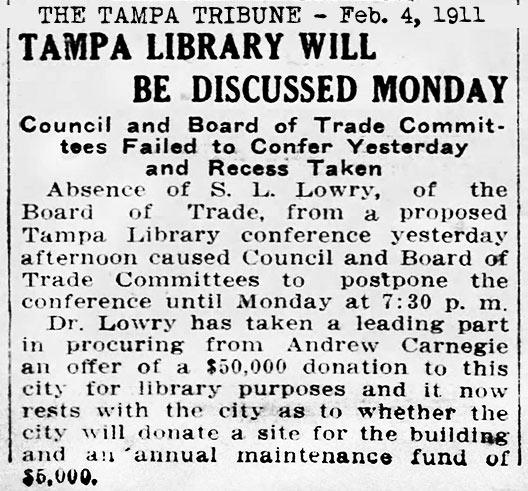LOWRY PARK BEGINNINGS
In order to tell the story of Lowry Park's
beginnings it's necessary to go back to the early 1900s of Tampa's
history. It was during the first mayoral term of Donald Brenham McKay
where we must begin the story, because the events that led to the creation of Lowry Park occurred
during his first mayoral term.
McKay became
City Editor of the Tampa Times in 1893, and seven years later, he owned
it and served as its publisher for the next four decades, which
included his terms as Tampa mayor. While he remained de facto
publisher of the Tampa Times, as mayor, D.B. McKay never used his position
to unfairly benefit his newspaper with regards to reporting the news.
In 1927, Tampa voters approved a new City Charter that reinstated the
mayor-city council form of government. Afterward, McKay decided to
campaign for mayor again and was overwhelmingly elected to another
four-year term.
Previous Mayors of Tampa, City of Tampa website
On October 7, 1900, D.B. McKay married
Aurora Gutierrez, a daughter of Gavino Gutierrez. Gavino was a
Spaniard who came to Tampa in search of a place to grow guavas on a large
scale. Before returning to New York, Gutierrez visited Key West and
met up for the first time with Vicente Martinez-Ybor. Both being
engaged in the cigar-making business, it was Gutierrez who persuaded Ybor
to consider visiting Tampa to investigate its superior advantages as a
desirable location for their cigar factories. This was the start of
what would become Ybor City and it's tremendous boost to the Tampa
economy.
From
Tampa Historical Society, About D. B. McKay
SUMTER de LEON LOWRY (SR.)
The Sumter Lowry in this section refers to the senior Lowry, not to
be confused with his son of the same name (Jr.) who was a member of
the National Guard and donated the first elephant to the Lowry Park
zoo.Sumter de Leon Lowry was born in
York, S. Carolina in 1861, a son of Dr. James M. and Louisa (Avery ) Lowry. The
Lowry family was established in South Carolina before the Revolutionary War; Dr. James Lowry was a surgeon in the 17th Carolina Regiment in the
Civil War.
DR. LOWRY SETTLES IN PALATKA,
FLA.
Sumter Lowry attended
South Carolina public schools and King’s Mountain Military School, and studied
pharmacy at the South Carolina Medical College. He first started in business as
a druggist in South Carolina and later owned a drugstore in Palatka, Fla., where
he moved in 1888.
By 1891, Dr. Lowry had entered the
insurance business and was an esteemed member of the Knights of
Pythias lodge.
|
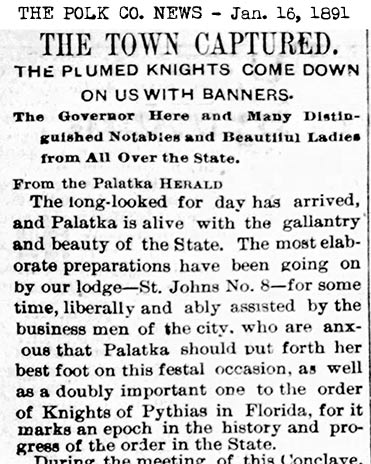 |
The Knights of
Pythias Lodge, St. Johns No. 8, held their festive celebration
"alive with gallantry and beauty" in January, 1891. The
celebration consisted of an invasion and capturing of
the city, along with parades, marching bands and contests.
(In 1904, Gasparilla would start a yearly tradition very much
in the style of the Pythians.)
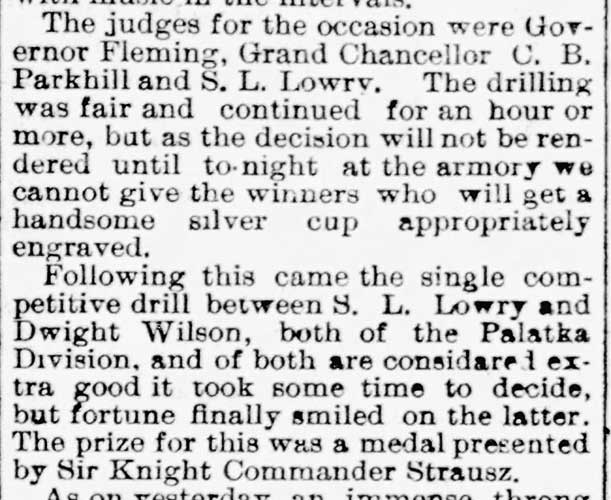 Sumter
L. Lowry participated in the events, one of which was a
one-on-one competitive drill with Dwight Wilson. Both
competitors were equal to the task, but "fortune finally
smiled" in favor of Wilson, who received a medal. Sumter
L. Lowry participated in the events, one of which was a
one-on-one competitive drill with Dwight Wilson. Both
competitors were equal to the task, but "fortune finally
smiled" in favor of Wilson, who received a medal.
These are two excerpts
from a large article about the celebration.
|
| |
Mar. 20, 1891:
Dr. Lowry treats a man suffering with blood poisoning. |
|

Lowry apparently
enjoyed fishing as seen by these two articles above and below.
|
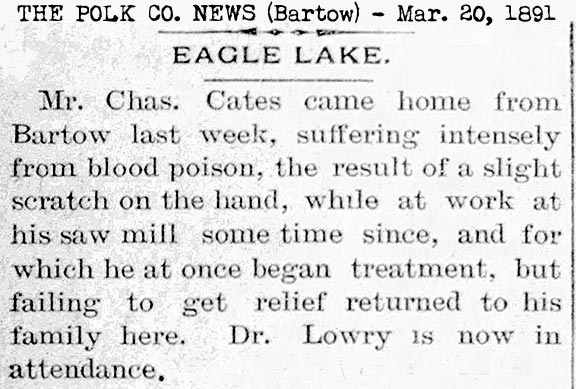 |
|
 |

Lowry was an
insurance agent before he moved to Tampa. |
|

DR. LOWRY IN TAMPA
Coming to Tampa in
1893, Lowry established the
insurance agency which was still in existence at the time this biographical
sketch was written by Karl Grismer (1950). Lowry also became a director of
the Gulf Life Insurance Company.
On April 16,
1895, a new Lodge of the Knights of Pythias was organized in
Tampa. About sixty men met in Lowry's office and
appointed five men to apply to the Grand Chancellor at Quincy,
Fla. for a charter and dispensation to organize the new lodge.
Dr. Lowry was among the five chosen, and after some discussion
they decided to call their new organization the Red Cross
Lodge Knights of Pythias. Plans were to elect officers
as soon as the charter was obtained. |
|
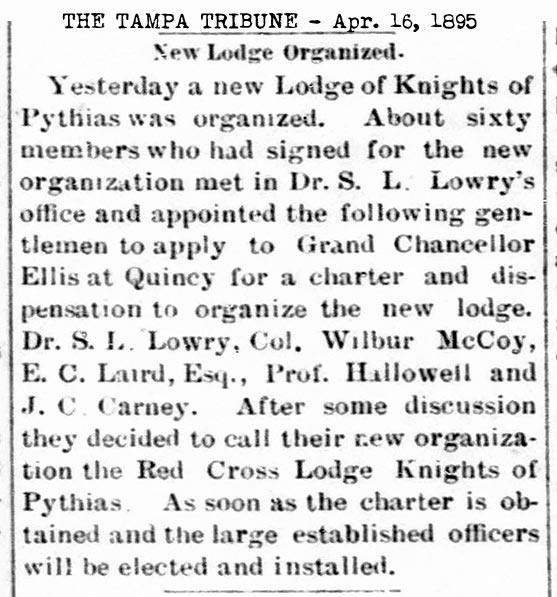 |
Nov. 13, 1895 - Lowry made a
trip to his old home in Palatka and found business in town to
be rather dull. A cigar factory established there
earlier proved to be a success, and the residents were
jubilant in their success of getting a sash and blind factory
located there.
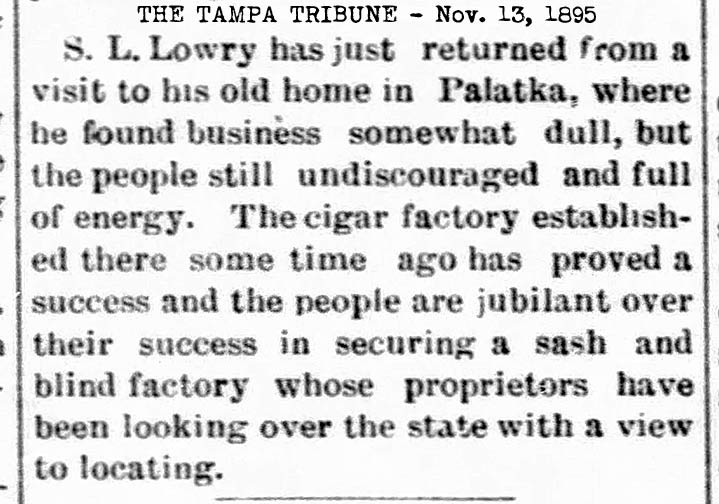 |
JAMES CRICHTON McKAY
In 1896, James C. McKay's wife,
young son, and maid came to Tampa from Fernandina, Fla. with
the intent to live here. James C. McKay was a son of Capt.
James McKay, Jr. and Mary Elizabeth Crichton McKay.
James C. was a U.S. Postal Clerk and returned to Tampa in July
the next year, after visiting other cities in the south.
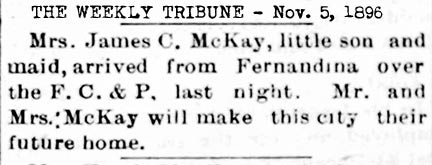
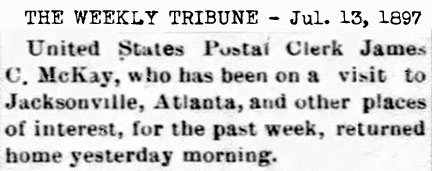
LOWRY AND JAMES C. McKAY
FORM "LOWRY & McKAY"
Although no articles or ads
could be found for this agency, it was likely around this time that James C. McKay
joined Dr. Lowry in the insurance business as "Lowry and
McKay." This is brought to light by an 1898 article
forthcoming.
|
|
DR. LOWRY'S
COW PROBLEM
Nov. 16, 1897 - Lowry
complained about the "depredations committed on his lawn and
garden" by the roaming cows in the 3rd Ward of the city.
He was tempted to take the law into his own hands. |
 |
|
LOWRY
JOINED BY W.H. OSBORNE
In July of 1898, W. H. Osborne, a minister at the First
Baptist Church in Tampa, bought out James C. McKay's
interest in the firm of Lowry and McKay, an agency that
represented "a number of the best insurance companies of the
country." |
LOWRY
PREVIOUSLY PARTNERED WITH J.C. MCKAY
Three days later, this article appeared, which not only
misspelled Lowry's name, it calls the new partnership by two
different names--Lowry & Osborne, the Osborne & Lowery.
The correct
name was Lowry & Osborne. |
|
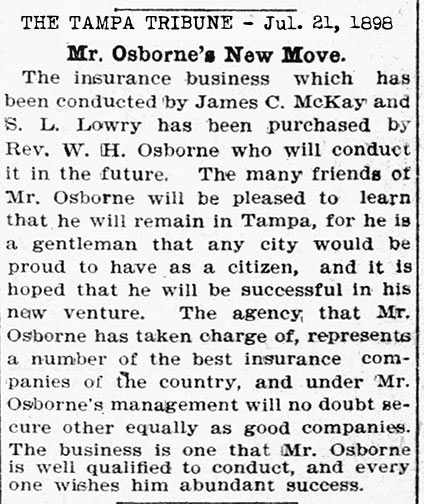 |
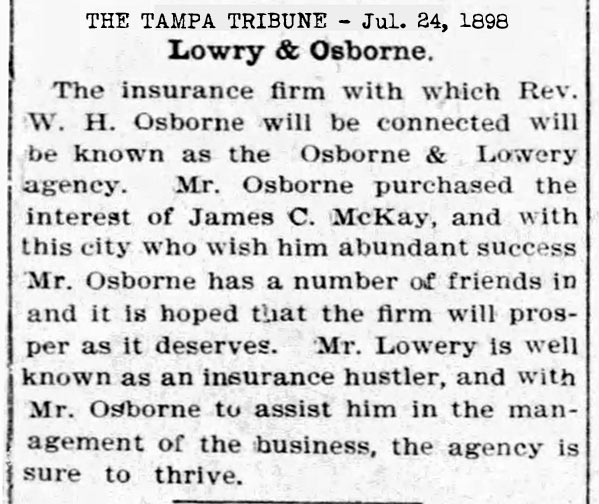
 |
|
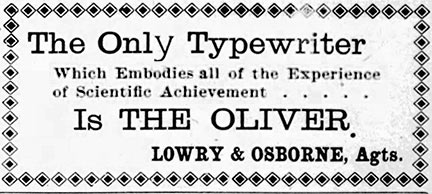
LOWRY & OSBORNE- AGENTS FOR THE OLIVER
TYPEWRITER |
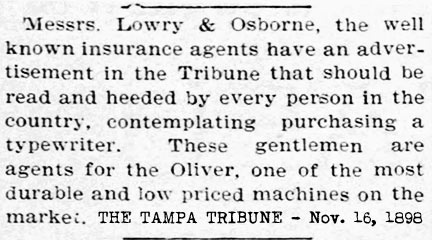 |
LOWRY & OSBORNE DISSOLVED
Less than two years after announcing their partnership,
notice was given that the firm was dissolved by mutual
consent and that Lowry was retiring. Clarifications
are published soon afterward that Lowry only sold out his
interest in the companies that Lowry & Osborne represented,
and he had the privilege to re-enter the business at any
time -- which he did. |
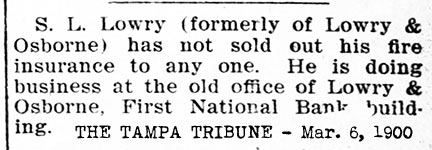 |
|
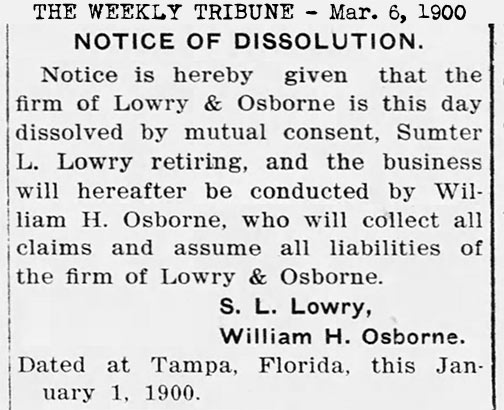 |
 |
A NEW MAYOR AND CITY COUNCIL TAKE OFFICE
June 14, 1900: A new Tampa mayor is sworn in,
Frank L. Wing, and S.L. Lowry has a seat on the new city
council as one of the two representatives of of the 1st
Ward. |
|
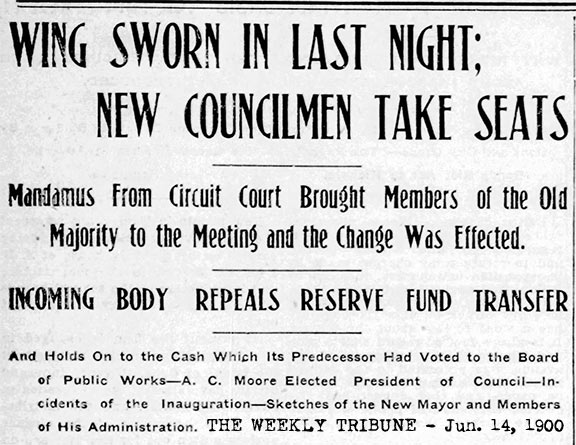 |
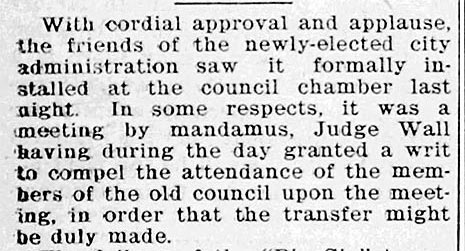 |
|
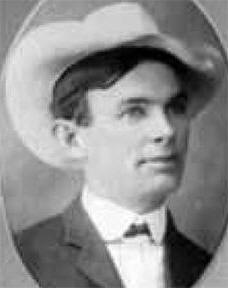
Francis
Lyman Wing
33rd And 37th Mayor Of Tampa
Born: May 9,
1868 Died: October 29, 1941
First Term:
June 8 1900 - June 4, 1902
Second Term:
June 5, 1908 - June 6, 1910
Francis "Frank" Wing
arrived in Tampa in 1889 where he opened a furniture store
and a laundry. Later, he became a successful real estate
developer. In 1922, he built the Puritan Hotel in the Hyde
Park district. He was also the director of the Lyons
Fertilizer Company.
In 1892, Wing
married Annie E . Hale, who had lived in Tampa since the age
of one. The following year, they built a house on north
Morgan Street where the couple raised their children. Wing
was a member of the City Council during the Spanish-American
War and served from June 1898 to June 1900. |
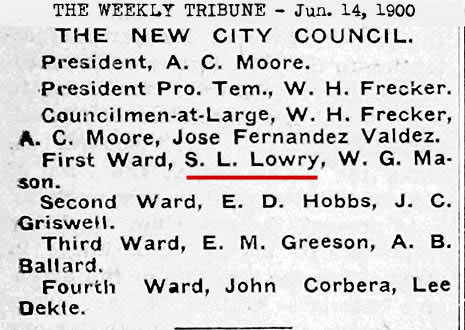 |
|
Wing ran
unopposed for mayor as the Citizens’ League candidate in
June 1900. During Wing’s first administration, Tampa
benefited from a steady population growth, due in part by
the economic prosperity from cigar manufacturing in Ybor
City, phosphorus export, and the Port of Tampa (Port Tampa
City 1893 – 1961). The population growth placed an enormous
strain on public works and services. In response, Wing and
succeeding mayors embarked on capital projects to improve
and expand the City’s public works and services to the
community. |
Mayor Wing info and
photo from "The Mayors of Tampa, 1856 - 2015" a project of
the City of Tampa
|
|
 |
GET TO KNOW THE CITY COUNCIL |
| The Tribune provides "Thumb-Nail
Sketches" of the new members of the City Council. A short
paragraph or two for each one, mostly about their occupations.
For S. L. Lowry, they wrote:
 |
|
But the Tribune
described the wrong S.L. Lowry in the "thumb-nail sketch."
Without admitting it was their mistake, they informed the public that the S.L. Lowry who is on the new
city council was not the insurance man, Sumter L. Lowry. The
council member was Samuel L. Lowry, an engineer.
(Yet, future articles about Sumter Lowry continued to use "S.L. Lowry.")
|
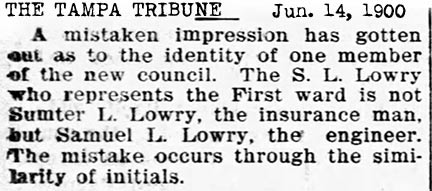 |
|
LOWRY IS GRAND CHANCELLOR OF THE
KNIGHTS OF PYTHIAS OF FLORIDA
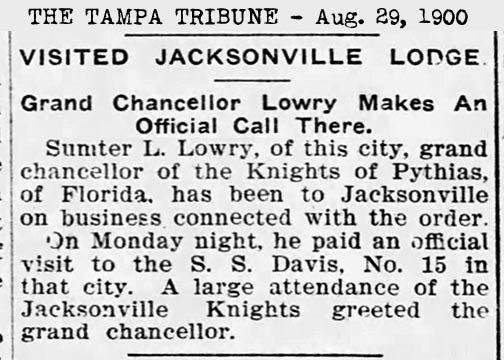
|
CITY COUNCILMAN
SAMUEL L. LOWRY RESIGNS
Councilman Lowry, the
engineer, moved out of the city limits and so had to resign.
This should end the confusion.
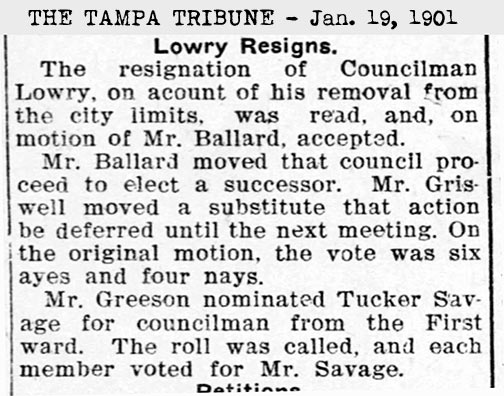 |
In the next 5 years or so, Lowry would be mentioned hundreds of times in
the papers. Most articles were either about his success as an
insurance salesman, or his involvement with the Knights of Pythias
Lodge. Almost as many were about his wife and her involvement with
society events and charities.
Here is a small sample of the types of
articles mentioning Sumter L. Lowry:
|
Mar.
1901 - Lowry is the Grand Chancellor of the Florida Pythian lodges |
Aug.
1902 - Testimonial letter for prompt payment of a large claim.
Lowry's office at 1 Davis Blvd. is not Davis Islands. It didn't
exist until 1925. |
Dec.
1903 - Lowry's business has remarkable increase over previous year.
He employs his nephew, J. Bratton Lowry. |
|
 |
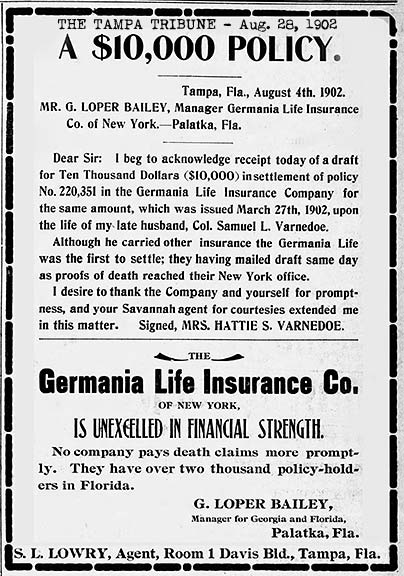
|
 |
|
May
1905 - Lowry's nephew resigns and starts his own business on Jackson
block. |
May
1905 - R.M. Prince, accountant with Knight & Wall Hardware, joins
Lowry firm. |
May
1909 - Lowry & Prince one of the top insurance companies in Tampa. |
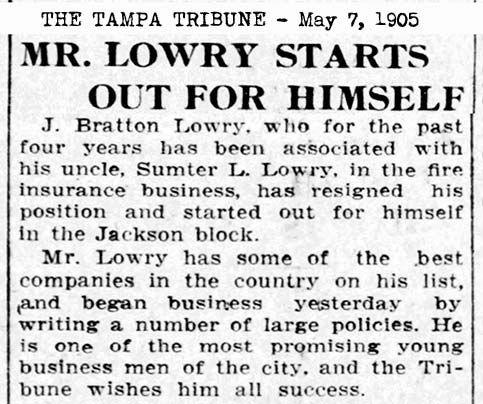 |
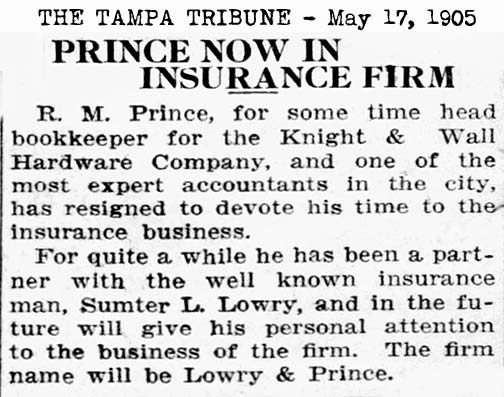 |
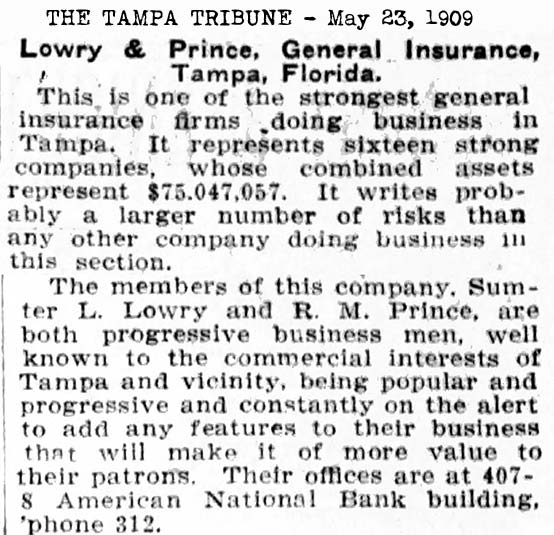 |
| TAMPA PUSHES FOR A CARNEGIE
LIBRARY A significant
event in the history of Tampa was the procurement of its first
public library.
Many Americans first entered the worlds of information and
imagination offered by reading when they walked through the front
doors of a Carnegie library. One of 19th-century industrialist
Andrew Carnegie’s many philanthropies, these libraries entertained
and educated millions. Between 1886 and 1919, Carnegie’s donations
of more than $40 million paid for 1,679 new library buildings in
communities large and small across America. Many still serve as
civic centers, continuing in their original roles or fulfilling new
ones as museums, offices, or restaurants.
Carnegie Libraries: The Future Made Bright, National Park Service
website
Andrew
Carnegie was once the richest man in the world. Coming as a dirt
poor kid from Scotland to the U.S., by the 1880s he'd built an
empire in steel — and then gave it all away: $60 million to fund a
system of 1,689 public libraries across the country. A total of 2,509
Carnegie libraries were built between 1883 and 1929, including some
belonging to public and university library systems. 1,689 were built
in the United States, 660 in the United Kingdom and Ireland, 125 in
Canada, and others in Australia, South Africa, New Zealand, Serbia,
Belgium, France, the Caribbean, Mauritius, Malaysia, and Fiji. At
first, Carnegie libraries were almost exclusively in places where he
had a personal connection - namely his birthplace in Scotland and
the Pittsburgh, Pennsylvania area, his adopted home-town. Yet,
beginning in the middle of 1899, Carnegie substantially increased
funding to libraries outside these areas. In later years, towns that
requested a grant and agreed to his terms were rarely ever refused. By the time the last grant was made in 1919, there were 3,500
libraries in the United States, nearly half of them built with
construction grants paid by Carnegie.
In order to pursue the
goal of obtaining a Carnegie Library in Tampa, a committee of six
men were chosen. Chairman James E. Crane, Dr. W.C. Richardson,
Sumter L. Lowry, R.M. Clewis, and Isham W. Phillips (namesake of
Tampa's Phillips Field.)
Below are excerpts
from a very long article.
See whole library article |
|
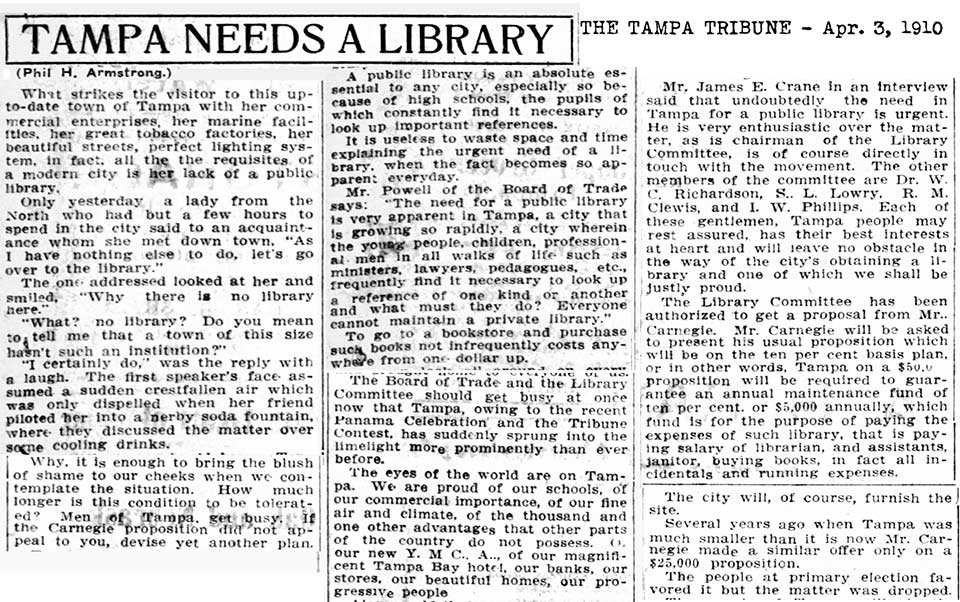 |
|
Nearly all of Carnegie's
libraries were built according to "the Carnegie formula," which required
financial commitments from the town that received the donation. Carnegie
required public support rather than making endowments because, as he
wrote:
"An endowed institution is liable to become the prey of a clique. The
public ceases to take interest in it, or, rather, never acquires
interest in it. The rule has been violated which requires the recipients
to help themselves. Everything has been done for the community instead
of its being only helped to help itself."
So Carnegie required the
elected officials—the local government—to:
-
Demonstrate the need
for a public library
-
Provide the building
site
-
Pay staff and maintain
the library
-
Draw from public funds
to run the library—not use only private donations
-
Annually provide ten
percent of the cost of the library's construction to support its
operation
-
Provide free service to
all.
Carnegie assigned the
decisions to his assistant James Bertram. He created a "Schedule of
Questions." The schedule included: Name, status and population of town,
Does it have a library? Where is it located and is it public or private?
How many books? Is a town-owned site available? Estimation of the
community's population at this stage was done by local officials, and
Bertram later commented if the population counts he received were truly
accurate, "the nation's population had mysteriously doubled."
Tampa planned to request a
contribution of $50,000 from Carnegie. The usual Carnegie
proposition was the 10% plan, so it would require Tampa to guarantee
$5,000 of annual funding for the library. This included paying
such library expenses as salary of a librarian and assistants,
janitor, purchase of books, and all incidentals and running
expenses. Several years earlier, Tampa made a similar offer on a
$25,000 proposition. Tampa's citizens voted for it in the
primary, but the matter was then dropped.
Lowry received a
response from Carnegie stating that he would be pleased to double
the previous donation amount to $50,000 and would make the funds
available as soon as Tampa complied with the conditions. "All
seem to agree that the corner of the Tampa Bay [Hotel] grounds, at
West Lafayette St. and Crescent Place would be the most admirable
location for the institution -- and this property belongs to the
city. (See green area on 1903 Sanborn map below.)
|
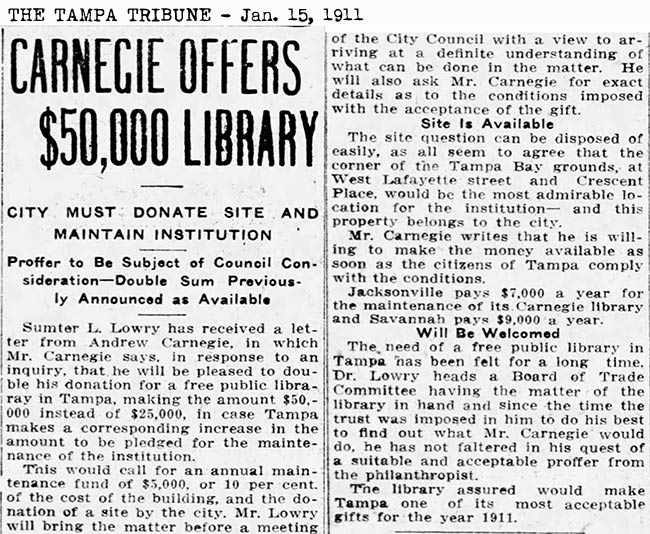 |
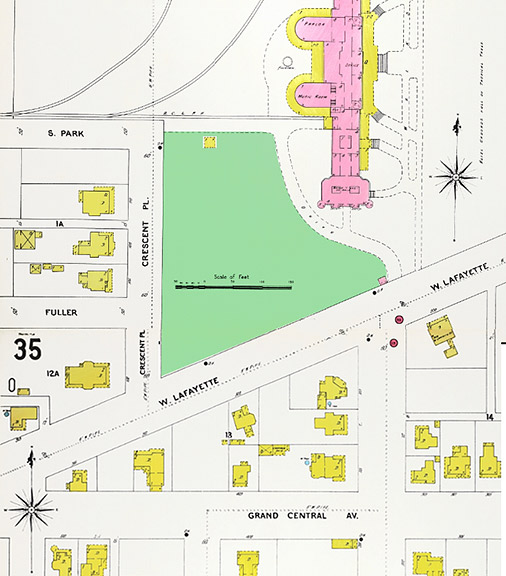 |
Carnegie Library from Wikipedia
How Andrew Carnegie Turned His Fortune Into A Library Legacy, by NPR's
Susan Stamberg
Always actively
interested in civic affairs, Dr. Lowry was one of the organizers and
the first president of the Commission Government Club of Tampa, and
when that form of government was adopted, was elected as one of the
commissioners, serving six years. While in office he took a leading
part in the purchase of the waterworks by the city, the installation
of the waterworks plant, the improvement of the harbor, the building
of the Municipal Hospital, the rehabilitation of Tampa Bay Hotel,
the building of five bridges, and the building of the beautiful
Bayshore Blvd.
A member of the Episcopal Church, he helped to raise funds for
the building of St. Andrews and was one of the founders of St.
John’s church. He was a delegate to the general conference of
Episcopal churches in 1928. He was a past grand chancellor of the
Knights of Pythias, a president of the Florida State Fire
Underwriters Association, and Commander in Chief of the National
Sons of Confederate Veterans.
Dr. Lowry married in SC to Willie Miller, of Raleigh, NC, in
1889.. During her
lifetime she was one of Tampa’s most earnest women workers. Included
among the organizations and institutions which she initiated and
supported were the Women’s Club, the YWCA, the Woman’s Exchange
Club, the Red Cross, the Colonial Dames and the American Legion
Auxiliary. She was one of the leaders in the campaign to acquire the
Tampa Public Library. Following her death, the Tampa Tribune stated
in an editorial that Mrs. Lowry “was the most active and effective
woman civic worker Tampa ever knew…she supplied most of the energy,
organizing ability and brains which figured in the cultural,
intellectual and social development of the city.” Mrs. Lowry died in
August, 1946 at the age of 85
Five children were born to Dr. and Mrs. Lowry: Willie Louise (Mrs
Vaughan Camp), Sumter L (Jr.), Blackburn W., Loper B., and the late
Isabella (Mrs. George Scott Lazare). Dr. Lowry died in May, 1934 at
the age of 75.
In 1910, McKay was elected to his first term
as Mayor of Tampa and served for 10 years in the position. In 1927, McKay ran for a four year term and
was overwhelmingly elected, raising his tenure as Mayor to a total of 14
years (1910-1920, 1927-1931).
During his years as mayor, McKay
implemented a massive expansion infrastructure in public works projects - streets were
paved, sidewalks built and sewer systems constructed throughout the city.
In addition, construction on City Hall was completed (1915), the third
(final) Lafayette
Street (Kennedy Boulevard) Bridge was completed, Tampa's first public
library opened (1917), brick fire stations were built as were the main
buildings for the South Florida Fairgrounds. All were accomplished with
McKay's oversight.
In 1918, Dr. Lowry urged the city
of Tampa to buy land north of Sligh Avenue at North Blvd and dedicate it for use as
a public park. (Some sources say he donated the land and suggested a
park be built.) Around 1925, after years of hard work, it became a
reality, and the park was later named in Lowry's honor. Sumter L. Lowry, Sr. died in
1934 at age 75.
|

 Sumter
L. Lowry participated in the events, one of which was a
one-on-one competitive drill with Dwight Wilson. Both
competitors were equal to the task, but "fortune finally
smiled" in favor of Wilson, who received a medal.
Sumter
L. Lowry participated in the events, one of which was a
one-on-one competitive drill with Dwight Wilson. Both
competitors were equal to the task, but "fortune finally
smiled" in favor of Wilson, who received a medal.



































